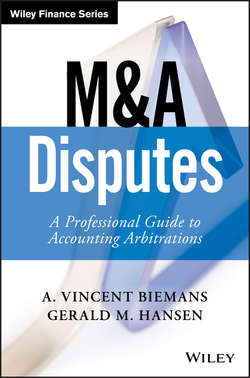Читать книгу M&A Disputes - Biemans A. Vincent - Страница 5
На сайте Литреса книга снята с продажи.
Preface
ОглавлениеWhy This Book
M&A transactions continue to be an important part of the corporate and investment landscape. Many of the purchase agreements governing those transactions contain post‐closing purchase price adjustment mechanisms. As a result, after‐the‐fact adjustments to the purchase price are commonplace.
In many instances, those adjustments remain limited to a series of uncontroversial accounting true‐ups. Purchase price adjustment mechanisms can, however, have a significant impact on the deal value to one or both parties. Sellers and buyers can be easily caught off guard by a sizeable proposed adjustment, problems with the company's accounting, or some perceived unreasonable position by the counterparty. In some instances, the impact on the ultimate purchase price paid by buyers and received by sellers can make or break transactions.
In the event of a dispute regarding a post‐closing purchase price adjustment, the purchase agreement commonly provides for the matter to be brought before an independent accountant for resolution. The parties rely on their attorneys and accountants to advise them on the successful resolution of those disputes before the accounting arbitrator. The resolution process, however, can be opaque for those unfamiliar with it and the area is under‐published. Moreover, there are distinguishing characteristics and unique considerations when comparing the field of M&A accounting arbitrations and the broader legal and accounting professions.
This book seeks to provide guidance to current and potential practitioners, whether in‐house or at a professional services firm, in resolving – and perhaps preventing – M&A disputes. It aims to provide the reader with an in‐depth walkthrough of the M&A dispute resolution process and practical guidance on achieving the best results for their clients from the diligence phase through final resolution. It also seeks to provide would‐be arbitrators with the handhelds needed to arrive at an informed and appropriate award. In addition to a discussion of the post‐closing purchase price dispute resolution process, this book also discusses steps the transaction parties can take to potentially mitigate the scope and severity of any post‐closing purchase price dispute.
The Organization of the Book
We have organized the book into five separate, but interrelated, parts.
The first part – The M&A Dispute Framework – provides an introduction to purchase price adjustment mechanisms, an overview of the post‐closing purchase price adjustment process, and the dispute resolution process before the accounting arbitrator. It also provides a more specific introduction to net working capital adjustment mechanisms. We selected net working capital adjustment mechanisms as the primary basis for discussion throughout most of this book for its prevalence in practice as well as the analogous applicability of many of the identified issues to other adjustment mechanisms. Notably, post‐closing adjustment mechanisms and the related dispute resolution process can be – and often are to some extent – customized as they are contractual in nature. Notwithstanding, the (net working capital) adjustment mechanisms and resolution procedures generally have more in common than they are different.
The second part – Core Concepts and Issues – discusses a variety of recurring elements across purchase price adjustments and disputes, including the nature of GAAP, the common requirement of consistency with historical accounting practices, the determination of target net working capital, transaction‐specific adjustments, selected audit topics, and subsequent events.
The third part – The Accounting Arbitration – provides a discussion of the dispute resolution process from the selection and retention of the accounting arbitrator through the arbitration award. Included are various considerations for the parties in preparing their submissions to the arbitrator as well as considerations for the arbitrator in reaching a determination on the items in dispute.
The fourth part – The Disputed Items – provides a detailed discussion of the drivers of many disputed items and several common categories of disputed items such as inventory, accounts receivable, and contingent liabilities. We discuss the genesis of such disputed items, important considerations when evaluating them, and how to present them to an accounting arbitrator. Although we cover some relevant accounting guidance, the emphasis is not on discussing all the ins‐and‐outs of GAAP. This book is not intended to be a technical accounting manual.
The final part – Other Topics – closes out the book with a discussion of several important topics, including the impact of contractual choices in the purchase agreement, the interaction between indemnification provisions and net working capital adjustment mechanisms, other purchase price adjustment mechanisms, and finally a brief discussion of international considerations.
